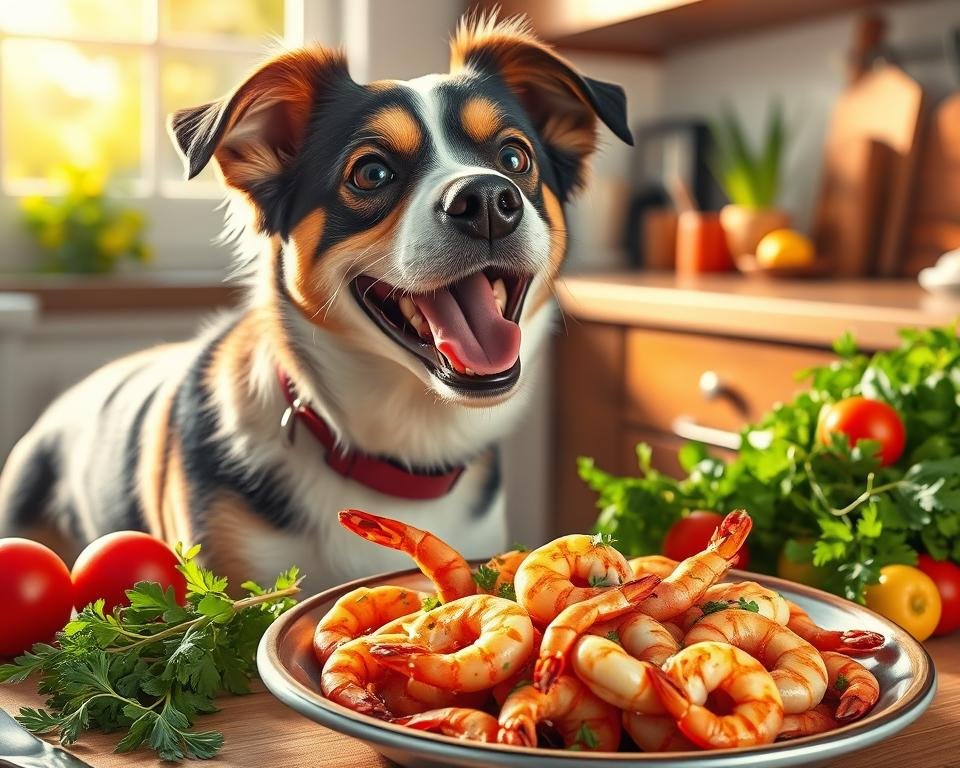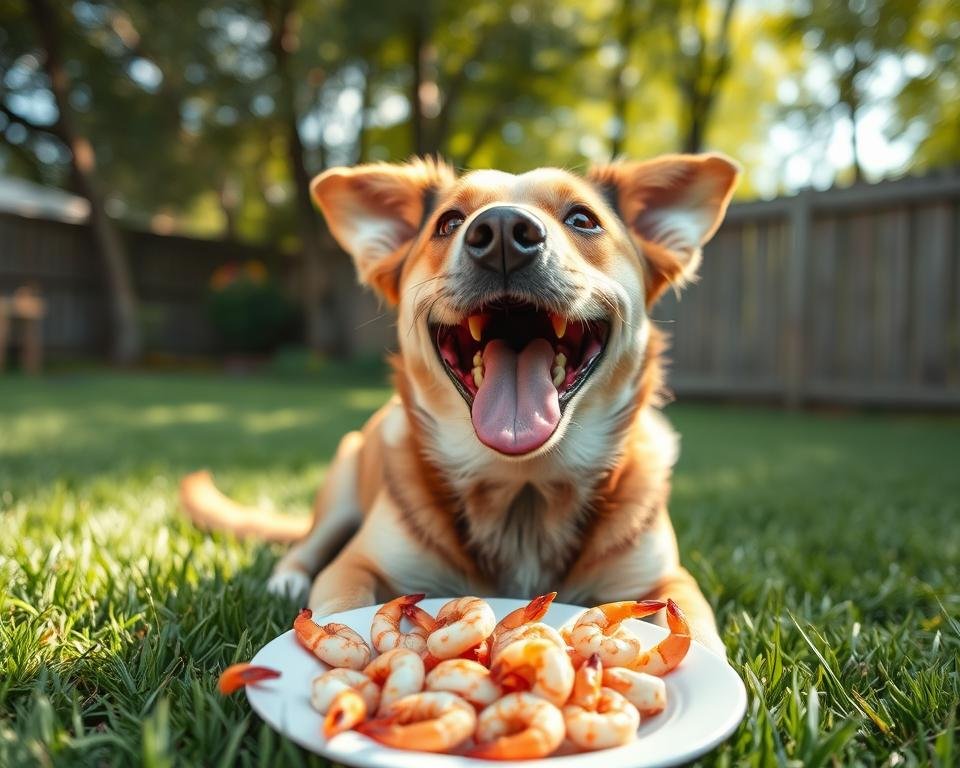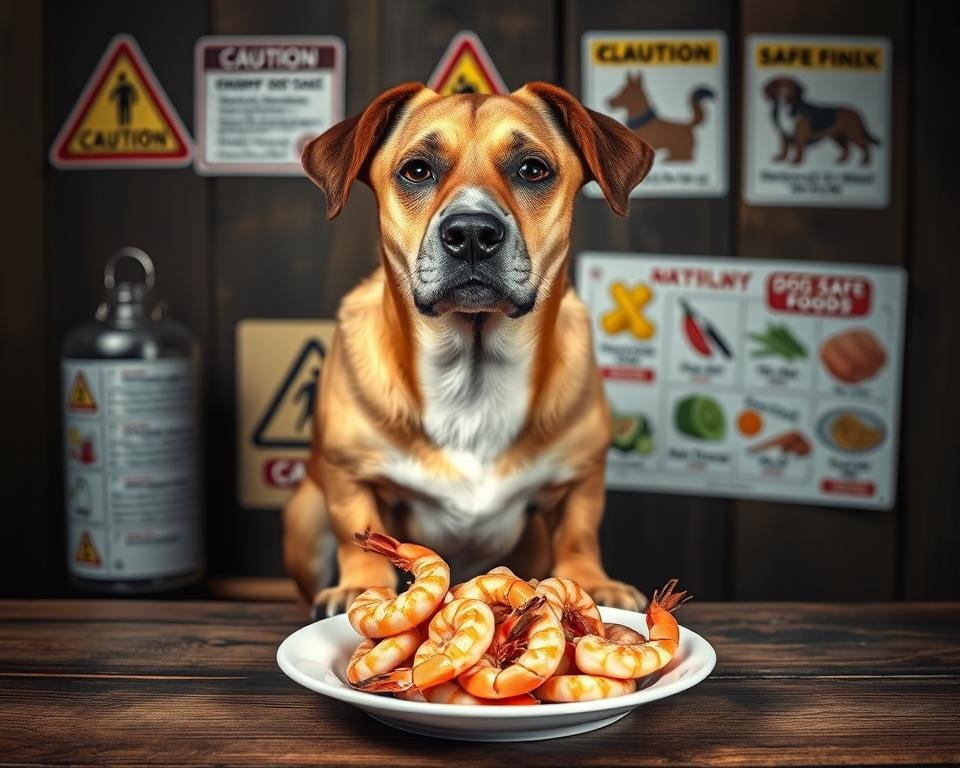As dog owners, we’re always looking for healthy treats for our pets. Shrimp is a low-calorie, nutrient-rich food that catches our eye. But is shrimp safe for dogs, and what should we watch out for when feeding shrimp to dogs? Let’s explore the good and bad of this seafood choice.
Cooked shrimp can be a safe, nutritious snack for dogs if given in small amounts. It’s a good source of protein, vitamin B12, niacin, and phosphorus. These nutrients are great for a dog’s health. But, there are some things to think about when it comes to dogs and shrimp. We need to be careful because of allergies, high cholesterol, and stomach problems.
Understanding the Safety of Shrimp for Dogs
Shrimp can be a tasty treat for dogs, but safety is key. It’s important to know how to prepare and serve it right. This ensures your dog stays healthy and happy.
Basic Safety Guidelines
To safely feed shrimp to dogs, cook it well. Remove the shells and tails. Also, skip any seasonings or additives. Raw shrimp can have harmful bacteria like Listeria and Salmonella, which can harm dogs.
Shrimp also has a lot of sodium. This can be bad for dogs with heart disease or high blood pressure. Watch how your dog reacts and talk to your vet if you’re worried.
Why Some Dogs Can’t Have Shrimp
Most dogs can have shrimp, but not all. Dogs with shellfish allergies may get sick. This can cause skin problems, stomach issues, or even anaphylaxis.
Dogs with pancreatitis should avoid shrimp because of its fat and cholesterol. Puppies, senior dogs, and dogs with weak immune systems are also at risk. Always check with your vet before adding shrimp to your dog’s diet.

Before giving shrimp to your dog, talk to your vet. This is true if your dog has health issues. By following safety tips and knowing your dog’s needs, you can enjoy shrimp safely.
The Nutritional Benefits of Shrimp for Dogs
Shrimp is a tasty treat for dogs and offers many nutritional benefits. It’s full of high-quality protein, vitamins, and minerals. These nutrients support your dog’s health and wellbeing.
Shrimp is low in calories and fat, making it great for dogs on a diet. It’s also rich in omega-3 fatty acids. These acids help reduce inflammation and keep your dog’s skin and coat healthy.
- Shrimp is a great source of vitamin B12, niacin, and phosphorus. These nutrients are important for energy, immune function, and bone health.
- It also contains antioxidants that protect your dog’s cells from damage. This supports overall health.
- Other nutrients in shrimp include choline, copper, iodine, and selenium. These support immune health, muscle strength, and organ function.
While shrimp is nutritious, it should only be 10% of your dog’s diet. Moderation is key. This way, your dog can enjoy the shrimp nutrition for dogs and benefits of shrimp for dogs safely.

Can Dogs Eat Shrimp: A Complete Guide
Feeding shrimp to dogs needs careful thought on serving sizes, how often, and if they like it. Shrimp can be good for dogs, but start slow and watch for any bad reactions.
Proper Serving Sizes
The right amount of shrimp for dogs depends on their size. Usually, one or two pieces are enough for most dogs. But, smaller dogs might only need a little bit to stay healthy. Always start small and watch how your dog reacts before giving more.
Frequency of Feeding
Shrimp should be a rare treat for dogs, not a regular food. Eating shrimp too often can upset their stomach or cause allergies. It’s best to give shrimp as a special treat, maybe once or twice a week, not every day.
Signs Your Dog Enjoys Shrimp
If your dog loves shrimp, they’ll show it. Look for tail wagging, paying close attention when shrimp is ready, and really wanting to eat it. But, watch for signs of sickness like vomiting or diarrhea, too, when trying shrimp for the first time.
Knowing the right amount, how often, and if your dog likes shrimp helps make it a safe treat. Always talk to your vet if you’re unsure about feeding shrimp to your dog.

Potential Health Risks and Concerns
Shrimp can be a tasty treat for dogs, but there are risks to consider. Shrimp risks for dogs include allergic reactions, high cholesterol, and digestive issues. Raw or undercooked shrimp can have harmful bacteria like Salmonella or Listeria, causing food poisoning.
Symptoms of shrimp-related illness in dogs include vomiting, diarrhea, fever, and lethargy. In rare cases, the high fat in shrimp can lead to pancreatitis in dogs. Shrimp shells and tails can also cause choking or intestinal blockages if swallowed.
“It’s important to consult your veterinarian before introducing any new food, including shrimp, into your dog’s diet.”
Shrimp can also be high in cholesterol, which is bad for dogs with circulatory issues or those prone to weight gain. Owners should watch how much shrimp they give their dogs and how often.
- Allergic reactions to shrimp are possible, though less common in dogs than in humans.
- Uncooked shrimp can harbor harmful bacteria like Salmonella and Listeria, leading to food poisoning.
- The high fat content in shrimp may trigger pancreatitis in dogs susceptible to the condition.
- Shrimp shells and tails can pose choking hazards or cause digestive issues if ingested.
- Shrimp’s high cholesterol content can be problematic for dogs with certain health conditions.

While shrimp can be a tasty and nutritious treat for some dogs, it’s important to think about the risks. Always talk to a vet before adding shrimp to your dog’s diet. Being a responsible pet owner is key to keeping your furry friend healthy and happy.
How to Properly Prepare Shrimp for Dogs
Feeding shrimp to your dog can be a fun treat. But, it’s important to prepare it right to keep them safe and healthy. When preparing how to cook shrimp for dogs or preparing shrimp for dogs, there are a few key steps to follow.
Cooking Methods
The best ways to cook shrimp for dogs are boiling or steaming. These methods kill off any bad bugs or bacteria. They also don’t add fats, oils, or seasonings that can harm your dog. Make sure to cook the shrimp until it’s white and not clear anymore.
Safety Precautions
- Avoid serving raw shrimp, as it can carry harmful pathogens that may cause gastrointestinal upset.
- Remove the shells and tails completely before serving, as they can pose a choking hazard or cause digestive problems.
- Do not add any extra seasonings, sauces, or oils, as these can be high in calories and potentially toxic to dogs.
- Cut the cooked shrimp into small, bite-sized pieces to prevent choking.
By following these simple preparation guidelines, you can safely give shrimp as an occasional treat to your dog. Always talk to your vet before trying new foods, like shrimp, for your dog, if they have health issues.
Shrimp can be a great addition to a dog’s diet if prepared correctly. But, it’s key to take the right steps to keep your dog safe and healthy. By following these guidelines, you can prepare shrimp for dogs in a way that’s safe and nutritious for them.
The Dangers of Raw Shrimp for Dogs
It might seem nice to give your dog a shrimp snack. But, it’s important to know the risks of raw shrimp. Raw shrimp can be harmful to dogs because of harmful bacteria and parasites.
Dogs can get sick from Salmonella, Vibrio, and Listeria in raw shrimp. They might vomit, have diarrhea, fever, and feel tired. Raw shrimp can also have tapeworms, which are bad for dogs.
Even if shrimp is not fully cooked, it’s risky. Make sure any shrimp you give your dog is cooked well. Cooking shrimp kills bacteria and reduces parasite risks.
“Consuming raw or undercooked shrimp can lead to serious bacterial infections or gastrointestinal upset in dogs,” warns Dr. Emily Singler, a veterinary nutritionist. “It’s always best to err on the side of caution and only feed shrimp that has been cooked through.”
For your dog’s health, it’s safer to avoid raw can dogs eat raw shrimp. Choose cooked shrimp or other safe seafood instead. Remember, the dangers of raw shrimp can be too great.
Shrimp Shells and Tails: Why They’re Hazardous
Dogs can eat cooked shrimp safely, but the shells and tails are risky. These parts are hard for dogs to digest because they contain chitosan. Their sharp edges can hurt a dog’s insides, even causing holes in the intestines.
Choking Hazards
Shrimp shells and tails are a big choking risk, mainly for small dogs or puppies. If a dog swallows them, these hard pieces can block the airway. It’s very important to remove all shells and tails before giving shrimp to your dog.
Digestive Issues
Shrimp shells and tails can also block the digestive system and cause pain. They are hard for dogs to digest and can lead to serious problems. To keep your dog safe, it’s best not to give them shrimp with shells or tails.
Knowing the dangers of shrimp shells and tails helps pet owners keep their dogs safe. Always be careful when feeding shrimp to your dog. If you’re worried, talk to your vet.
Signs of Shellfish Allergies in Dogs
Shrimp can be a tasty treat for many dogs. But, some dogs might be allergic to it. Dog shrimp allergy and shellfish allergy in dogs are common. Pet owners should know the signs.
The common signs of a dog shrimp allergy are vomiting, diarrhea, itchy skin, and hair loss. In severe cases, dogs can have anaphylactic shock, a life-threatening emergency. Symptoms of anaphylaxis include trouble breathing, swelling, excessive drooling, and collapse.
Other signs of shrimp intolerance are gastrointestinal upset and loss of appetite. If your dog shows these symptoms after eating shrimp, stop feeding it shrimp right away. Then, talk to your vet as soon as possible.
“Moderation is key when introducing new foods to dogs, minimizing the risk of severe allergic reactions.”
It’s important to be careful when adding shrimp or seafood to your dog’s diet. Watch for any bad reactions to keep your dog safe and healthy.
Healthy Seafood Alternatives for Dogs
Feeding your dog safe seafood can be a great choice. While shrimp might be tasty, there are better options. These alternatives are full of omega-3 fatty acids and protein.
Sardines are a great pick. They have low mercury and lots of good oils. These oils help your dog’s skin, coat, and health. Cooked salmon is also good, with high-quality protein and anti-inflammatory benefits. Green-lipped mussels are great too, as they support joint health with glucosamine and chondroitin.
Other safe fish options include whitefish (like cod or haddock), trout, mackerel, and herring. Always cook fish well and remove bones to avoid choking. Non-seafood proteins like chicken, turkey, beef, and lamb are also good for your dog’s diet.
Start with small amounts of new foods and watch for any bad reactions. Talk to your vet before adding these fish alternatives to your dog’s safe seafood for dogs or fish alternatives for dogs.
“The key to a healthy, balanced diet for your dog is variety. Incorporating a range of protein sources, including safe seafood options, can provide essential nutrients and promote overall well-being.”
When to Consult Your Veterinarian
As a responsible pet owner, knowing when to ask your vet about your dog’s diet is key. Shrimp can be a tasty treat for dogs, but there are times when you should get your vet’s advice.
Emergency Situations
If your dog keeps vomiting, has diarrhea, or won’t eat after eating shrimp, call your vet right away. These could mean an allergic reaction or digestive problems that need quick help. Also, if your dog shows signs of anaphylaxis like trouble breathing, swelling, or collapse, get to the vet fast.
Professional Dietary Advice
Dogs with health issues, a history of pancreatitis, or special diets need vet advice before trying shrimp. Your vet can tell you how much to feed, how often, and if shrimp fits into your dog’s meal plan.
Regular vet visits are also important. They help keep an eye on your dog’s health and talk about any diet changes or shrimp concerns. Your vet’s advice is key to your dog’s health and a balanced diet.
“Consulting your veterinarian is the best way to ensure your dog’s safety and health when it comes to feeding shrimp or other human foods.”
Being proactive and getting professional advice helps you navigate dog nutrition. This way, you can keep your furry friend happy and healthy.
Special Considerations for Puppies and Senior Dogs
Feeding shrimp to puppies and senior dogs needs extra care. Puppies have growing immune systems and might get upset stomachs or allergies. Start with small, cooked, plain shrimp pieces when they start eating solid foods.
Senior dogs can get benefits from shrimp’s omega-3 fatty acids and vitamins. But, their health and any age-related issues should be considered.
Introduce shrimp slowly and in small amounts to puppies and senior dogs. Watch for any bad reactions. Puppies might need even smaller pieces to avoid choking. Senior dogs might need special portions based on their health.
Always talk to your vet before adding shrimp or new foods to your dog’s diet. This ensures their safety and health.
With the right steps, shrimp can be good for puppies and senior dogs. It adds important nutrients and helps their health. Working with your vet, your dog can enjoy shrimp’s benefits safely.
FAQ
Q: Can dogs eat shrimp?
A: Yes, dogs can have shrimp if it’s cooked right. Cooked, deveined, and shelled shrimp is safe for dogs. It gives them protein, vitamins, and nutrients.
Q: Is shrimp bad for dogs?
A: Shrimp is usually safe for dogs when given in small amounts and cooked correctly. But, there are risks like allergies, high cholesterol, and stomach problems. So, it’s important to be careful.
Q: Can dogs eat shrimp tails?
A: No, dogs should not eat shrimp tails. They can choke on them and cause stomach issues. Make sure to remove the shells and tails before giving shrimp to your dog.
Q: Can dogs have shellfish?
A: Some dogs can have shellfish like shrimp in small amounts. But, others might have allergies. It’s best to introduce shellfish slowly and watch for any bad reactions.
Q: How much shrimp can dogs eat?
A: The right amount of shrimp for dogs depends on their size. Usually, one or two pieces of cooked, deveined shrimp is enough. Shrimp should be an occasional treat, not a regular part of their diet.
Q: Can dogs eat raw shrimp?
A: No, dogs should not eat raw shrimp. It can have harmful bacteria and parasites. Raw shrimp can make dogs very sick, so make sure it’s cooked well before giving it to them.
Q: What are the signs of a shrimp allergy in dogs?
A: Signs of a shrimp allergy in dogs include vomiting, diarrhea, itchy skin, hair loss, and in severe cases, anaphylactic shock. If your dog shows these symptoms after eating shrimp, stop giving it to them and see a vet right away.
Q: What are good seafood alternatives for dogs?
A: Good seafood alternatives for dogs are sardines, cooked salmon, and green-lipped mussels. They are full of omega-3 fatty acids and protein. Other safe fish options are whitefish, trout, mackerel, and herring.
Q: When should I consult a veterinarian about feeding shrimp to my dog?
A: You should talk to a vet if your dog keeps vomiting, has diarrhea, or loses their appetite after eating shrimp. If your dog shows signs of anaphylaxis or severe allergic reactions, get them to a vet fast. Your vet can also help with what food is best for your dog.


